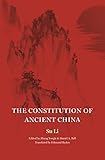The Constitution of Ancient China : Not Assigned / Su Su Li; ed. by Zhang Yongle, Daniel A. Bell.
Material type: TextSeries: The Princeton-China Series ; 9Publisher: Princeton, NJ : Princeton University Press, [2018]Copyright date: ©2018Description: 1 online resource (304 p.) : 1 b/w illusContent type:
TextSeries: The Princeton-China Series ; 9Publisher: Princeton, NJ : Princeton University Press, [2018]Copyright date: ©2018Description: 1 online resource (304 p.) : 1 b/w illusContent type: - 9780691171593
- 9781400889778
- Constitutional history -- China
- Culture and law -- China
- HISTORY / Asia / China
- Chinese characters
- Chinese empire
- Common Program of 1949
- Confucianism
- Germany
- Great Learning
- Great Wall
- Mandarin Chinese
- Qin dynasty
- Su Li
- Third Reich
- Weimar Constitution
- administrative divisions
- ancient China
- beliefs
- bureaucracy
- civilization
- commandery system
- constitution
- constitutional continuity
- constitutional discontinuity
- constitutional law
- constitutionalism
- cosmology
- cultural community
- cultural constitution
- effective constitution
- emperor
- examination system
- feudal clan law
- feudal system
- geoclimatic conditions
- geopolitics
- institutions
- knowledge
- large state
- legitimacy continuity
- legitimation
- meritocracy
- political life
- political order
- political rationalization
- politico-cultural elites
- politics
- reading
- recommendation system
- revolution
- rites
- scholar-officials
- selection system
- social consensus
- structural functionalism
- territory
- traditions
- unified script
- unified speech
- uniform weights
- 342.31029 23
- KNN2090 .S826 2019
- online - DeGruyter
- Issued also in print.
| Item type | Current library | Call number | URL | Status | Notes | Barcode | |
|---|---|---|---|---|---|---|---|
 eBook
eBook
|
Biblioteca "Angelicum" Pont. Univ. S.Tommaso d'Aquino Nuvola online | online - DeGruyter (Browse shelf(Opens below)) | Online access | Not for loan (Accesso limitato) | Accesso per gli utenti autorizzati / Access for authorized users | (dgr)9781400889778 |
Frontmatter -- CONTENTS -- EDITORS' ACKNOWLEDGMENTS -- Editors' Introduction -- Introduction -- Part I -- CHAPTER 1. The Constitution of the Territory and Politics of a Large State -- CHAPTER 2. Ancient China's Cultural Constitution: A Unified Script and Mandarin Chinese -- CHAPTER 3. Scholar-Officials -- Part II -- CHAPTER 4. The Mixed Han-Tang-Song Structure and Its Moral Ideal: A Reply to Professor Su Li's Account of the Chinese Constitution -- CHAPTER 5. The Symbolic and the Functional: Su Li on the Constitution of Ancient China -- CHAPTER 6. The Ideal of Civilization and Formation of Institutions in Ancient China: A Reply to Su Li -- CHAPTER 7. History, Culture, Revolution, and Chinese Constitutionalism -- Part III -- CHAPTER 8. Response to My Critics -- Glossary Of Key Terms -- Notes -- Bibliography -- Index
restricted access online access with authorization star
http://purl.org/coar/access_right/c_16ec
How was the vast ancient Chinese empire brought together and effectively ruled? What are the historical origins of the resilience of contemporary China's political system? In The Constitution of Ancient China, Su Li, China's most influential legal theorist, examines the ways in which a series of fundamental institutions, rather than a supreme legal code upholding the laws of the land, evolved and coalesced into an effective constitution.Arguing that a constitution is an institutional response to a set of issues particular to a specific society, Su Li demonstrates how China unified a vast territory, diverse cultures, and elites from different backgrounds into a whole. He delves into such areas as uniform weights and measurements, the standardization of Chinese characters, and the building of the Great Wall. The book includes commentaries by four leading Chinese scholars in law, philosophy, and intellectual history--Wang Hui, Liu Han, Wu Fei, and Zhao Xiaoli-who share Su Li's ambition to explain the resilience of ancient China's political system but who contend that he overstates functionalist dimensions while downplaying the symbolic. Exploring why China has endured as one political entity for over two thousand years, The Constitution of Ancient China will be essential reading for anyone interested in understanding the institutional legacy of the Chinese empire.
Issued also in print.
Mode of access: Internet via World Wide Web.
In English.
Description based on online resource; title from PDF title page (publisher's Web site, viewed 27. Sep 2021)


